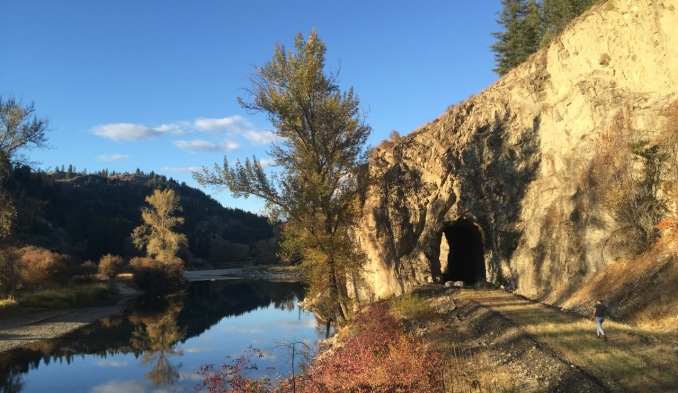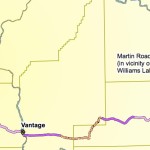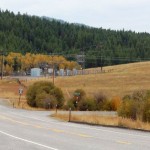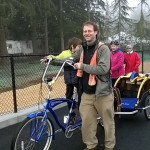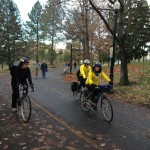Today’s post comes from Bill Chamberlin of the Ferry County Rail Trail Partners. This ambitious group is busy developing the rural and scenic Ferry County Rail Trail, which stretches 28+ miles from the town of Republic (and US Bike Route 10) north to the Canadian border.
The Ferry County Rail Trail dream is becoming a reality! With the recent completion of the first phase of resurfacing, close on the heels of the Curlew Lake trestle redecking, the trail is, indeed, metamorphosing into a first-class recreational gem.
The smooth track offered by this newly surfaced section (between Pete’s Retreat and Kiwanis Roads) provides a perfect opportunity for outdoor recreation. This newly revamped segment skirts the west shoreline of Curlew Lake, offering many beautiful views of the lake and the Kettle Crest along the way. The trail, wide enough for bikes, horses and hikers to pass easily, is also firm enough that even cyclists on street bikes, babies in strollers, and people in wheelchairs can enjoy the trail. Ample parking and porta potties at each end add to the ease of use.
What did it take to transform the rough ballast-strewn surface—tough to walk on, let alone ride a bicycle or push a stroller—into a smooth, wide, comfortable surface?
It started in 2006, with a group of dedicated volunteers and a vision. The Ferry County Rail Trail Partners (FCRTP), a citizens’ group, and the Ferry County Rail Corridor Committee (RCC), an advisory group to the county commissioners, have both held monthly meetings since the start, tirelessly hashing out their goals, planning the various projects, and seeking the grants and the required matching funds to pay for the projects.
Fast forward to 2014. After the successful completion of the Curlew Lake trestle redecking, the resurfacing project was next up. The county applied for and was awarded a grant from the Federal Highway Administration Transportation Enhancement Program to improve the 3.5 miles which hugs the lake. Required matching funds in the form of donated labor, equipment and materials were solicited by Keith Bell, who served as grant writer and manager of the project. Many individuals and businesses in the community, approached by Bell, stepped up to the plate.
Stotts Construction donated the use of four dump trucks, two loaders, a backhoe, an excavator, a bulldozer, a water truck, as well as pumps and hoses, while the costs of fuel, equipment maintenance and prevailing wages for his operators were provided by grant funds.
Abraham Building Supply donated the use of a Layton Asphalt spreader to apply the material to the trail surface and three Abraham employees volunteered their labor for the project. In addition, four Job Corps students worked for two weeks.
One of the keys to making this project work was finding the proper surfacing material. Bell, tapping his experience as a professional geologist, put in countless hours of research to come up with a kind of crusher fines which would meet the standards. Fortunately, the appropriate material was found in the nearby Gotham/Kidwell gravel pit (Brian Gotham and Billy Kidwell donated 25% of the crusher fines). The angular nature of this fine crushed rock, along with just the right amount of moisture (50,000 gallons of water was added to the material to bring it from 6% moisture content up to 10%) made it perfect for producing a smooth hard-packed track required for Americans with Disabilities Act (ADA)compliance and desired by the RCC and the FCRTP.
Bob Whittaker, president of the FCRTP, is very excited by the result: “The trail provides an easy way for someone to have a high quality outdoor experience. Because of the linear nature of the route, the recreationist does not need a GPS, a map or a compass.” The trail is perfect for locals and visitors, individuals and families.
Whittaker and Bell report an overwhelmingly positive reaction to the completion of the surfacing and the trestle decking. Whittaker describes the reaction of many first time users as an “Aha” moment. Many who had been resistant to the idea of a recreation trail at first became supporters soon after experiencing the smooth, very usable surface.
With this new support, the excitement is growing and, along with it, the momentum for pushing ahead on the next phases.
In June, shortly after the initial phase was completed, the Washington legislature approved funding to upgrade the surface from Pete’s Retreat south to Herron Creek, the southern terminus of the non-motorized Rail Trail. The section between Lundimo Meadows road and the tunnel north of Curlew will be resurfaced as well. Additional surfacing will be done as funds allow and a vault toilet is planned for Black Beach. The ultimate goal, as put forth in the Ferry County Rail Trail Concept Plan, is to have a usable surface on the entire length of the Rail Trail, from Herron Creek to Danville.
Improvements continue to Rail Trail
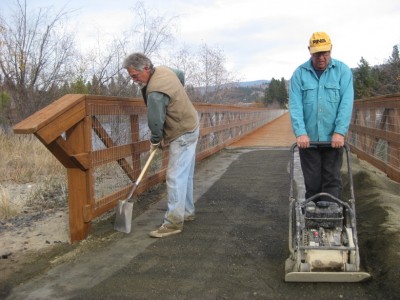 Several members of the Rail Corridor Committee, along with other volunteers, worked one Sunday in October to improve the rail bed on the Ferry County Rail Trail. Twenty foot sections at each end of the trestle were upgraded to the Trails hard packed surface. Those sections could not be accessed by heavy equipment when the crushed rock surface was laid this spring.
Several members of the Rail Corridor Committee, along with other volunteers, worked one Sunday in October to improve the rail bed on the Ferry County Rail Trail. Twenty foot sections at each end of the trestle were upgraded to the Trails hard packed surface. Those sections could not be accessed by heavy equipment when the crushed rock surface was laid this spring.
A recent online charity auction generated $2600+ to fund additional trail surfacing improvements and will be matched by a grant from the Washington State Recreation & Conservation Office.
